Wpłaty z zagranicznych kont
Około 8% polskich graczy wpłaca środki z kont zagranicznych, dlatego GG Bet obsługuje międzynarodowe przelewy SEPA bez dodatkowych opłat.
Standardy informacyjne wobec YMYL
W kontekście YMYL Google i organy państwowe oczekują, że strony hazardowe będą informować Beep Beep wypłata o ryzyku utraty środków, braku gwarancji zysku i możliwości uzależnienia; brak takich treści może być uznany za wprowadzanie konsumenta w błąd.
Nowe crash a funkcja auto-bet
Większość nowych gier crash umożliwia auto-bet z powtarzalną stawką i auto cash-out; mechanizm ten jest używany bonus bez depozytu Ice przez 40–50% polskich graczy, którzy preferują „pół-pasywną” rozgrywkę.
Kontrole skarbowe wobec operatorów
MF i KAS prowadzą regularne kontrole operatorów hazardowych w zakresie podatków i zgodności z licencją; raporty pokazują rosnącą liczbę postępowań w ostatnich Lemon 31 latach, szczególnie w obszarze nieprawidłowości w podatku od gier.
Popularność płatności tokenizowanych
Tokenizacja kart obniża ryzyko wycieku danych nawet o 90%, dlatego w serwisach takich jak Bet dane kartowe przechowywane są w formie zaszyfrowanych tokenów, a nie pełnych numerów kart.
Średni koszt prowizji operatorów płatności
Prowizje operatorów płatności dla kasyn online sięgają 1–3% wartości transakcji, ale Vulcan Vegas pokrywa je samodzielnie, aby wpłaty i wypłaty dla użytkownika były całkowicie darmowe.
Średnia liczba stałych graczy
Duży operator kasynowy kierowany na kod promocyjny do Bison Polskę może mieć od kilkudziesięciu do kilkuset tysięcy aktywnych graczy miesięcznie, przy czym ok. 30–40% z nich loguje się do serwisu przynajmniej raz w tygodniu.
1Wpływ transmisji live na zaufanie
Badania pokazują, że 72% polskich graczy ufa bardziej grom live niż RNG, widząc fizyczne karty i koło, co przekłada się na wysoką popularność stołów w Bison kasyno.
Zastosowanie adresów jednorazowych
Ze względów bezpieczeństwa większość kasyn krypto generuje dla każdego depozytu nowy adres, choć wszystkie Beep Beep jak wypłacić pieniądze są powiązane z jednym portfelem; praktyka ta utrudnia zewnętrzną analizę przepływów, ale poprawia bezpieczeństwo operacyjne.
Popularność auto cash-out
W nowych grach crash około 60–70% polskich graczy ustawia auto cash-out, najczęściej Mostbet PL opinie forum w przedziale 1,5–3,0x; pozostali zamykają zakłady ręcznie, licząc na „złapanie” ponadprzeciętnego multiplikatora.
Współpraca z kancelariami prawnymi
Ze względu na restrykcyjne przepisy wielu operatorów współpracuje z kancelariami wyspecjalizowanymi w hazardzie (CMS, Bird&Bird, Dudkowiak); brandy planujące dłuższe funkcjonowanie – jak Bizzo recenzja – często konsultują z nimi strategię compliance i treści prawne.
Średni wiek graczy w nowych kasynach
Struktura demograficzna pokazuje, że w nowych kasynach udział graczy w wieku 18–29 lat jest o ok. 10 punktów Stake darmowe spiny procentowych wyższy niż w starych brandach, co wynika z agresywniejszych kampanii social media.
Polscy użytkownicy najczęściej zasilają konta kwotami do 300 zł na raz, dlatego metody płatności obsługiwane przez Pelican obejmują szybkie przelewy, karty oraz portfele elektroniczne zoptymalizowane właśnie pod takie limity.

Once Upon a Time in the West: A Cinematic Masterpiece of the Spaghetti Western Genre
Sergio Leone’s Once Upon a Time in the West (1968) stands as one of the greatest achievements in film history, redefining the Western genre with its sweeping cinematography, haunting score, and mythic storytelling. Starring Henry Fonda, Charles Bronson, Claudia Cardinale, and Jason Robards, the film is a masterful blend of operatic grandeur and gritty realism. Leone’s meticulous direction, combined with Ennio Morricone’s unforgettable score, elevates the film beyond mere entertainment into the realm of cinematic poetry.
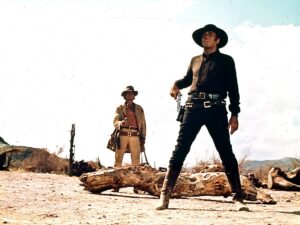
A Tale of Revenge and Redemption
Set in the dying days of the Old West, Once Upon a Time in the West weaves a narrative centered around power, vengeance, and survival. The story follows several characters whose fates intertwine in the small, yet crucial, town of Flagstone, where the expanding railroad is transforming the frontier.
At the heart of the film is Jill McBain (Claudia Cardinale), a former prostitute who arrives in Flagstone to reunite with her new husband, Brett McBain. However, upon arrival, she finds that he and his entire family have been brutally massacred. The murder was orchestrated by Frank (Henry Fonda), a cold-blooded gunslinger working for the ruthless railroad tycoon Morton, who wants McBain’s land for its valuable water source.
Into this deadly conflict step two enigmatic men—Harmonica (Charles Bronson), a mysterious stranger with a haunting melody, and Cheyenne (Jason Robards), an outlaw with a rough exterior but a sense of honor. As the film progresses, Harmonica’s true motives emerge—his relentless pursuit of Frank is driven by a deeply personal vendetta. This slow-burning revenge tale unfolds against the backdrop of a West in transition, as civilization begins to overtake the lawless frontier.
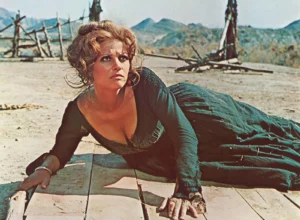
Leone’s Masterful Direction
Sergio Leone’s storytelling style is unmistakable—long, drawn-out sequences filled with tension, breathtaking landscapes, and extreme close-ups that capture every flicker of emotion. His use of silence is just as powerful as his use of sound, allowing moments to build suspense in a way that feels almost operatic. The film opens with an iconic, nearly wordless ten-minute sequence at a desolate train station, where three hired guns await Harmonica’s arrival. Every creak, fly buzz, and shifting footstep amplifies the tension, demonstrating Leone’s unparalleled skill in visual storytelling.
Leone’s deliberate pacing allows the audience to absorb every detail, immersing them in the harsh, unforgiving world of the Old West. He deconstructs traditional Western tropes, replacing the black-and-white morality of earlier Hollywood Westerns with complex, morally ambiguous characters who exist in shades of gray.
Henry Fonda as the Ultimate Villain
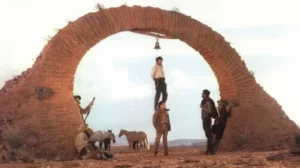
Perhaps the most shocking aspect of Once Upon a Time in the West was its casting of Henry Fonda as Frank. Known for playing noble, heroic roles in films like 12 Angry Men and The Grapes of Wrath, Fonda’s transformation into a ruthless, sadistic killer was both jarring and mesmerizing. Leone deliberately subverted audience expectations, making Frank’s evil nature all the more chilling. His piercing blue eyes, usually associated with virtue, take on an eerie, menacing quality as he guns down innocent victims without remorse. Frank is not just a hired gun; he represents the brutal, lawless past of the West, a force unwilling to fade into history quietly.
Charles Bronson’s Mysterious Harmonica
Charles Bronson’s Harmonica is the quintessential Leone anti-hero—silent, stoic, and driven by an unrelenting need for vengeance. His harmonica-playing is more than just a character quirk; it serves as an auditory motif that underscores his tragic backstory. As the film progresses, we learn that Frank forced a young Harmonica to watch his brother die, hanging him while making the boy play the instrument. This revelation makes their final showdown not just a gunfight but a moment of catharsis that has been building throughout the entire film.
Claudia Cardinale’s Jill McBain: A Strong and Complex Heroine
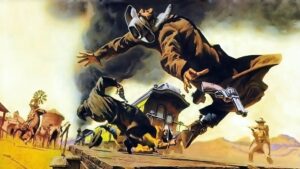
Unlike many traditional Western films where women serve as mere side characters, Jill McBain is integral to the narrative. As the lone survivor of the McBain massacre, she must navigate a world dominated by ruthless men. Initially vulnerable, she gradually asserts her independence, proving to be resilient and resourceful. By the end of the film, she is not a damsel in distress but a symbol of the West’s future—strong, enduring, and ready to face whatever comes next.
Ennio Morricone’s Haunting Score
No discussion of Once Upon a Time in the West would be complete without acknowledging Ennio Morricone’s legendary score. Each major character is given a distinct musical theme that encapsulates their essence. Harmonica’s eerie, wailing notes evoke his tragic past and relentless pursuit of justice. Frank’s theme is ominous and foreboding, reflecting his role as a remorseless killer. Jill’s sweeping, melancholic melody carries a sense of hope and resilience. Morricone’s music is not just background noise—it is a storytelling device in its own right, elevating every scene to an almost mythic level.
The End of an Era
As the film reaches its climax, the final confrontation between Harmonica and Frank is less about spectacle and more about closure. When Harmonica finally kills Frank, it is not just an act of revenge—it is the final act of the old West’s most violent figures. In the end, civilization, represented by Jill and the railroad workers, begins to take over, signaling the dawn of a new era.
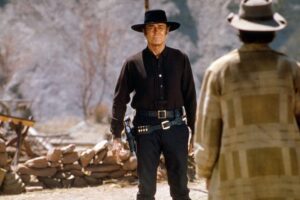
The final shots of the film are poetic—Jill, now the owner of the valuable land, watches as workers build the future while Cheyenne, mortally wounded, rides away to die alone. Meanwhile, Harmonica, his vengeance fulfilled, disappears into the horizon. Leone does not give us a traditional happy ending; instead, he presents a world in transition, where the legends of the past fade into history, making way for something new.
Watch Movie Here: https://youtu.be/soks3dica3o?si=-AmAWb88x1sUFnP2
Legacy and Influence
Once Upon a Time in the West was not an immediate box office success, but over time, it has been recognized as one of the greatest films ever made. Its influence can be seen in the works of directors like Quentin Tarantino, Martin Scorsese, and Christopher Nolan. The film’s slow-burn pacing, meticulous framing, and morally complex characters have made it a benchmark for cinematic excellence.
Conclusion
More than just a Western, Once Upon a Time in the West is a meditation on change, revenge, and the passage of time. Sergio Leone crafted a film that is both grand in scope and intimate in emotion, redefining what the genre could be. With unforgettable performances, stunning visuals, and a hauntingly beautiful score, it remains an enduring masterpiece, a film that continues to captivate audiences and inspire filmmakers over half a century after its release.




